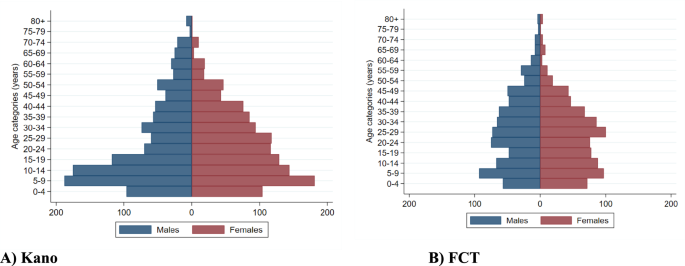In June 2021, SARS-CoV-2 seroprevalence was over 40% in the FCT and Kano State after the second COVID-19 wave. COVID-19 vaccination coverage was below 5% among vaccine-eligible participants approximately three months after vaccine introduction in Nigeria. Despite high awareness of the vaccine, a large proportion of the population did not intend to get vaccinated, with safety concerns being the most frequent reason. About 35% of those who intended to get vaccinated reported the protection for themselves as the most frequent reason.
The COVID-19 seroprevalence study in the FCT and Kano State in Nigeria was conducted between the second and third waves of the COVID-19 pandemic. This period of the pandemic was characterized by relaxation of public policies and infection prevention measures. At the time Nigeria started the COVID-19 vaccination programme, it was likely that few people were wearing masks, and more people were gathering indoors to eat, drink, celebrate and socialize without physical distancing, leaving many people vulnerable to infection. It was also the beginning of the spread of the Delta variant, considered, at the time, to be the most contagious variant of the SARS-CoV-2 virus39.
The seropositivity in the FCT (40.3%) and Kano State (42.6%) in June 2021, was almost twice as high as the seropositivity in Lagos State, which is considered to be the epicenter of COVID-19 in Nigeria, with 23.3% from October 202014,40,41. However, the time difference between the two surveys, with the waves of virus spreading, likely contributed to observed difference found in the results of the survey. In another study in Lagos, the seropositivity was considerably high when compared with seropositivity in the first study Antibody data demonstrated high SARS-CoV-2 seroprevalence of 72·4% (97/134) in HCWs and 60·3% (70/116) in the general population was observed. This high SARS-CoV-2 with low mortality rate in Africa and supports the need to better understand the implications of SARS-CoV-2 cellular immunity and, coverage of other parts of the geopolitical zones in the country18. A range of surveys during the beginning of the pandemic found ranges from 10.6% in Zambia, 32% in Cameroon, 9.1% in Kenya, 7.6% in Addis Ababa, Ethiopia, and varied seroprevalence from 30.6%–46.2% in subdistricts Cape Town, South Africa7,42,43,44,45.
Similar to the study in Cape Town, seroprevalence rates in a community survey in Zimbabwe conducted in 2020 and again in 2021, before and after second wave, were 2.47 times higher after the second wave46. Ndongo, et. al, reported findings from Yaounde, Cameroon, where the overall age-standardized SARS-CoV-2 IgG seroprevalence increased from 18.6% in the first survey conducted during the first quarter of 2021 to 51.3% in the second survey conducted in second quarter of 202147. These studies showed that COVID-19 seropositivity increased with sustained transmission and number of waves. However, temporality, variant of concern, and variant of interest could influence the interpretation of these results. Follow up seroprevalence studies are recommended to detect trend in seropositivity for sustained SARS-CoV-2 transmission.
The seropositivity in both regions was similar in men and women. Seropositivity was also similar in urban and rural areas in FCT and Kano. In the FCT, higher seropositivity was found in adults 18–64 years old and was lower in both extremes of life (younger and older) when compared with Kano State where seropositivity increased with age. This contrast could be ascribed to household representation in each region, with more urban households in FCT and more rural ones in Kano State. The similarity in age and SARS-CoV-2 infection varied across different study environments, however, other researchers found low seroprevalence in the younger children14. A systematic review and meta-analysis of standardized seroprevalence studies by Lewis, et. al., on African studies concluded that seroprevalence was highly heterogeneous; lower seroprevalence for rural than urban geographic areas with children aged 0–9 years having the lowest seroprevalence48.
In this study, in both the FCT and Kano State, only 22.6% of seropositive individuals in the survey showed no less than one symptom compatible with SARS-CoV-2 in the last six months (since November 2020). While more than 4 in 10 people had evidence of prior infection (seropositivity of 40.3% in the FCT and 42.6% in Kano), no single SARS-CoV-2 PCR-positive individual was detected among survey participants in either the FCT or Kano State. Fryatt, et. al., in Zimbabwe observed that almost half of all participants who were seropositive, reported no symptoms in the preceding six months49. In Mexico, 67.3% had been asymptomatic in a nationally representative SARS-CoV-2 antibody prevalence estimate after the first epidemic wave50.
This emphasized the importance of carrying out valid seroprevalence studies during active outbreaks of microorganisms with predominantly asymptomatic phenotypes.
to provide evidence-based data in understanding the burden of the disease and mobilizing resources for effective control. The observed similarity in symptom reporting by seroprevalence status was consistent across the two states and in the first round of surveys in four states14.
Only a small percentage of the population (14.4% of symptomatic seropositive women and 7.2% of symptomatic seropositive men) had at least one co-morbidity. Data show that patients with COVID-19 disease, who have comorbidities, are more likely to develop more severe disease. Similarly, infected older patients, (65 years and above) with comorbidities, have an increased admission rate with poor prognosis. Intensified public health measures aimed at protecting this category of patients from contracting COVID-19 can reduce the disease burden in the population51,52.
Understanding the burden of SARS-CoV-2 and its associated risk factors is fundamental to identifying key risk mitigation strategies. Comparing the findings of the surveys of the first four (Enugu, Gombe, Lagos and Nasarawa) states and this present survey in the FCT and Kano State, the first four states found higher seroprevalence among the older age group and identified frequent visits to the market and reported contact with someone with COVID-19 symptoms suggestive of COVID-19 as factors associated with seropositivity14. According to Oyetunde, Alao, Akinsola et al., observed no significant associations were found between seropositivity and familiar demographic factors like age, gender, or occupation indicating global transmission across all groups. However, they observed elevated seroprevalence among married individuals, self-employed workers, suggesting higher exposure in household and occupational settings, opined the need to tailor public health strategies with local data53.
In the present study, the survey participants who were 10 years and above in Kano State had higher seropositivity in comparison with those less than 10 years of age; however, this observation of differences in SARS-CoV-2 seropositivity and age in FCT were not observed.
This findings from COVID-19 seroprevalence studies in Kano and the FCT has provided information on area with high risk and need to consider vaccinating high-risk groups such as the elderly, healthcare workers, areas with low immunity and individuals with comorbidities in the distribution of vaccine across the country, The integration of the COVID-19 with other routine immunization will help in the vaccines uptake.
These two settings are malaria endemic as other parts of Nigeria, current/recent infection with malaria or of malaria with previous infection of SARS-CoV-2 was higher among rural dwellers, adolescents and young adults, and those in poorer wealth quintiles, compared to urban dwellers, adults and senior adults, and those in the highest wealth quintile in both states, largely reflecting background patterns of malaria infection risk in Nigeria49. Vaccines, including those for COVID-19, have been proven to be effective interventions that can reduce the high burden of diseases globally51. Globally, the COVID-19 pandemic was associated with high mortality rate54 spurring a large investment in rapid vaccine development. With the development and supply of the vaccines, it is essential that a critical mass of the population gets vaccinated. This underscores the need for the government to prioritise vaccine manufacturing to provide enough vaccines are available for those that need it across the region. In Central Africa, Manirakiza, Malaka, Mossoro-Kpinde et al. noted sharp increase in the seroprevalence among health worker (HCWs) after pre and post vaccination serosurveys and attributed the increase to be primarily due to the synergistic effect of the infection and the implementation of vaccines against COVID-1955.
Misconception, misinformation, and other conspiracy theories affected both COVID-19 virus transmission and vaccination, as observed in Nigeria25. COVID-19 vaccine hesitancy and the initial lack of availability of the vaccines affected public uptake of the COVID-19 vaccine in different ways25. It is paramount for the policies makers to map out risk communication strategies to engage the gate keepers and religious leader to providing transparent information about vaccine safety and efficacy, and countering misinformation and vaccine hesitancy that might be created during the vaccine rollout56.
In this study, there was higher awareness of the COVID-19 vaccine in FCT (78%) compared to Kano (49%), although the desire to take it among those aware was higher in Kano (61%) compared to FCT (47%). Hesitancy around COVID-19 vaccines has been seen in other settings globally. In Jordan, the public acceptability of COVID-19 vaccines was low (37.4%)57. In western Ethiopia, healthcare professionals in the study area had negative attitude towards the COVID-19 vaccine58. Knowledge about the COVID-19 vaccine, age of healthcare workers, and place of work are factors which affect attitudes towards COVID-19 vaccine. Vaccination coverage was low in both states (2.7%). Major reasons reported for low uptake of the COVID-19 vaccine in Nigeria included quality, efficacy/ability of the vaccine to protect, initial unavailability of the vaccine, distrust of the government, non-acceptance of COVID-19, conspiracy theories, disbelief, vaccine safety and side effects, and the fear of the unknown25. “This is a very significant occasion—the arrival of the COVID-19 vaccines into Nigeria is critical in curbing the pandemic. The only way out of this crisis is to ensure that vaccinations are available to all.” The initial vaccine supply to Nigeria was targeted towards the vaccination of Nigerians in priority groups, starting with frontline healthcare workers. Accessing the COVID-19 vaccine by the general public at this initial stage of the vaccine rollout was difficult59. Public awareness campaigns centered on reviving trust in national health authorities that offer transparent, accurate, and consistent information about the safety and efficacy of the vaccines, as well as the technology used to produce them would be beneficial. Adapting a guiding policy as above to gate keepers and religious leaders to counter misconception and vaccine hesitancy is apt in Nigeria and other African countries.
Limitations to the study
A higher refusal rate was observed in this survey than in the previous serosurveys, which may lead to biased results if those missed were not represented by those surveyed. Survey teams encountered hesitation among residents to participate in the survey due to a lack of trust in the government and other misconceptions associated with COVID-19. The self-reported rates of various symptoms were generally lower than expected, raising the possibility of recall bias for the symptom questions. Finally, the survey was conducted only three months after the commencement of COVID-19 vaccination in Nigeria. At this point, COVID-19 vaccine access and uptake could be still low, affecting the vaccination coverage among respondents in both the FCT and Kano State. With the recommended 8 to 12 weeks between dose 1 and dose 2 of the Astra Zeneca vaccine, most respondents were likely not yet eligible for their second dose.











